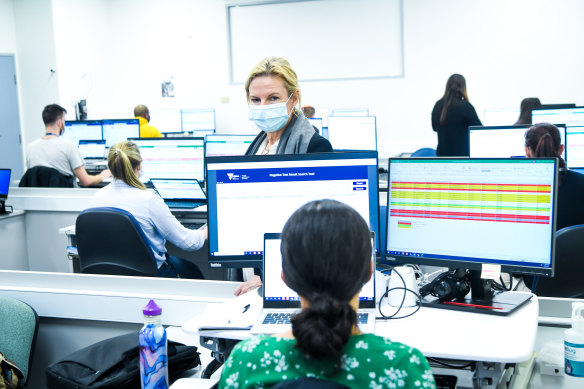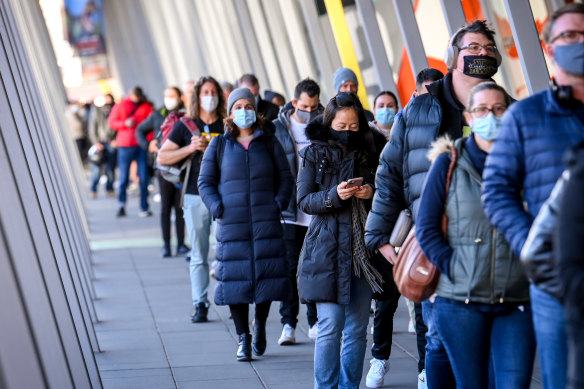This was published 4 years ago
Opinion
It makes no sense to ask ‘why Melbourne?’
Waleed Aly
Columnist, co-host of Ten's The Project and academicWhy Melbourne? That is the question. And everyone’s asking: exasperated Melburnians, Sydneysiders both smug and sympathetic, politicians looking to score a point. Epidemiologists have seriously attempted to provide answers, too, musing on demographics, weather, town planning, and the mobility of population. It’s a question with intuitive and emotional appeal, especially if you’re living through the grinding reality Melburnians have endured. I’ve instinctively been asking it myself.
But here’s the thing: it’s a bad question. It might even be a dangerous question. We shouldn’t be asking it.

A normally busy Bourke Street Mall in Melbourne during this latest lockdown.Credit: Photo: Getty
That’s because it’s an overwhelmingly (and understandably) emotional question posing as an analytical one. In truth, though, it’s an analytically meaningless question for one very simple reason: it is trying to discover a pattern from a sample size of two. And that is an absurd thing to do.
Because however you want to dress this up, it all comes down to the current outbreak and last winter’s wave. Nothing else. The endless talk of Melbourne’s “fourth lockdown” is misleading because one of these lockdowns was national (indeed, nearly global), and another was a short circuit-breaker of the kind we’ve seen in Adelaide, Perth, and twice in Brisbane. It is not the number of lockdowns that sets Melbourne apart. It is the nature of the outbreaks. That’s what lies behind the suggestion that Melbourne cannot control outbreaks in the way other cities do.
Except that if you want to suggest this, you’d have to include in your sample the Black Rock outbreak over the new year – which many seem to have forgotten – and which Victoria contained without a lockdown in precisely the manner NSW often does. You’d also have to include the breach of Australian Open hotel quarantine in February, which Victoria handled simply by listing exposure sites. Once you do that, the idea that Melbourne is so negatively special as a matter of course becomes immediately less compelling. It retreats once more to being entirely about these two exceptional outbreaks.
That might have had the faint echo of something meaningful if these two outbreaks had lots of significant things in common. But apart from the fact they’re both in Melbourne, they have nothing in common at all. The first originated from a breach of Victoria’s hotel quarantine system, the second from South Australia’s. Although it now appears the Delta strain escaped from quarantine in Victoria.
Victoria’s contact tracing system last year was abysmally small and under-resourced, while this time it is a vast operation that – even on the testimony of the Commonwealth’s Chief Medical Officer – is doing a first-rate job.

Contact tracing in Victoria has vastly improved on last year.Credit: Justin McManus
Put simply, the first major outbreak was almost entirely the fault of the Victorian government. The current one almost entirely isn’t. Suddenly our sample size of two isn’t even that. It’s two quite separate samples, each made up of a single event.
Indeed, the current outbreak is unique in our country’s experience so far. Its origin is a man who contracted the virus in quarantine, but tested negative all the way through. Having been cleared, he then moved about the community for six days while he was infectious, before being detected when his symptoms led him to get tested. That is a truly extraordinary situation.
You could argue perhaps it should test everyone who has left hotel quarantine again, say, two or three days after they’re released. But no other state requires that. The Northern Territory just introduced it in response to this outbreak, and NSW only recommends it. Even then, if people choose to get tested, they don’t have to isolate while they await their results if they don’t have symptoms. This man would have been out and about for days anywhere in Australia.
Then it took two weeks for a second positive case to show up. That means there was a mystery link, but this isn’t particular to Victoria, either: NSW never found the mystery source of its northern beaches outbreak. What made Victoria different was that when more cases emerged, they came with a list of the worst kind of exposure sites, including bars and clubs. That’s what made the lockdown unavoidable, and made a localised lockdown of the kind we saw in the northern beaches less viable. Unless we want to argue that people going to bars and clubs is uniquely Melburnian, this isn’t geographically meaningful, either.

People queue up for COVID-19 vaccinations at the Melbourne Convention and Exhibition Centre. Credit: Eddie Jim
The result is an outbreak with a remarkably flukey beginning, that was three weeks under way before it was identified. Now we learn a major factor in its spread is that people waited for a few symptomatic days before getting tested, and it is impossible to believe only Victorians do this. In sum, there’s little concrete reason to conclude any other jurisdiction would have detected it sooner. The basic (if popular) idea that other states have managed similar outbreaks better is false for the simple reason that no other state has faced one with these features.
Similarly, there is no good explanation for why this “keeps happening” in Melbourne, because something that has happened twice in completely incomparable ways isn’t something that “keeps happening” to begin with.
The truth is we understand what caused each outbreak very well, and they don’t permit a unified explanation. To insist on one is to chase a mirage. That might be understandable, but unfortunately this lazy Melbourne exceptionalism isn’t benign. It risks tempting every other major city into a false sense of security on the assumption that such outbreaks are simply a Melbourne thing. That is probably a major reason vaccination centres are bursting in Melbourne, but not elsewhere. Perhaps when Australia looks at Melbourne’s outbreak, it doesn’t see its own reflection. Perhaps instead of seeing a warning or a call to action, it sees something that just happens to other people. And given the obviously perilous implications of that, isn’t this a line of thinking we should resist?
Waleed Aly is a regular columnist.